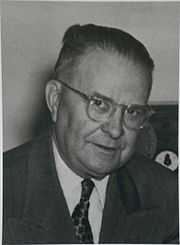Edwin B. Swope
| Edwin B. Swope | |
|---|---|
 | |
| Born |
May 6, 1888 Santa Fe, New Mexico |
| Died |
December 26, 1955 (aged 67) San Francisco, California |
| Known for | Warden of Alcatraz Federal Penitentiary (1948–1955) |
Edwin Burnham Swope (May 6, 1888 – December 26, 1955), nicknamed "Cowboy", was the second warden of Alcatraz Federal Penitentiary, which was situated on Alcatraz Island, California, US. He was a native of New Mexico, having been born at Santa Fe in 1888.[1] His earlier posts as warden included New Mexico State Prison, Washington State's McNeil Island Federal Penitentiary,[2] and the Federal Penitentiary at Terre Haute, Indiana.[3] Swope served at Alcatraz from 1948 to 1955.[4] A member of the Democratic Party, Swope was Chairman of the City Commission of Albuquerque, New Mexico from February 1923 through February 1925. He was appointed Commissioner of Public Lands by New Mexico Governor Arthur T. Hannett.[5]
Warden of Alcatraz Federal Penitentiary
Swope was the last political appointee to serve as Alcatraz's warden,[4] and the only Alcatraz warden who did not have an escape attempt while serving in that role.[6] He and his wife lived in the Warden's House on Alcatraz Island.[7] He was described as having a soft voice, gray hair, and wore rimless eyeglasses.[8] His fashion style of sombrero, cowboy boots, and rings and belt buckles of turquoise bore out his southwest heritage. Swope was approximately 5 feet, 9 inches tall, and of slender build; he was a fan of horse racing.[4]
In his first 18 months as warden, Swope introduced painting and a prisoners' orchestra as reform measures.[9] He was a strict disciplinarian but unlike his predecessor, James A. Johnston, he was considered the most unpopular warden of Alcatraz with his officers and the inmates.[10] He once said, in response to an inmate who complained to him on the recreation yard about his term of 199 years, which was really a life sentence, "My boy, we're all doing life. Every one of us is doing life."[6] In 1950, Swope brought movies to the Alcatraz, which were viewed in the chapel every other weekend, although at some stage movies were shown in the auditorium above the dining room.[11] At the age of 66, he resigned from his post at Alcatraz on January 21, 1955 shortly before his death.[6]
References
- ↑
- ↑ National Conference of Social Work (U.S.). Session (1939). Proceedings of the National Conference of Social Work at the ... Annual Session held in .... The Conference. p. 768. Retrieved 8 September 2012.
- ↑ American Correctional Association (1944). Proceedings of the annual Congress of Correction. pp. 257, 262. Retrieved 8 September 2012.
- ↑ 4.0 4.1 4.2 Gregory, George H. (28 April 2008). Alcatraz Screw: My Years as a Guard in America's Most Notorious Prison. University of Missouri Press. pp. 83, 114–. ISBN 978-0-8262-1396-9. Retrieved 5 September 2012.
- ↑ Keleher, William Aloysius (30 April 2008). Memoirs, Episodes in New Mexico History, 1892–1969. Sunstone Press. pp. 138–. ISBN 978-0-86534-623-9. Retrieved 8 September 2012.
- ↑ 6.0 6.1 6.2 Champion, Jr, Jerry Lewis (27 January 2011). The Fading Voices of Alcatraz. AuthorHouse. pp. 11, 107, 119–. ISBN 978-1-4567-1487-1. Retrieved 5 September 2012.
- ↑ "Warden and Mrs. Swope". Museum Management Program, Golden Gate National Recreation Area. Retrieved 6 September 2012.
- ↑ Bruce, J. Campbell (14 March 2012). Escape from Alcatraz. Random House Digital, Inc. pp. 126–. ISBN 978-0-307-81583-5. Retrieved 8 September 2012.
- ↑ "Prison Meeting is Told of Alcatraz Art Show: Convicts on the 'Rock' Encouraged to Paint as Reform Measure, Warden Says". The Milwaukee Journal. September 24, 1949. Retrieved 8 September 2012.
- ↑ Dunbar, Richard (1 January 1999). Alcatraz. Casa Editrice Bonechi. pp. 53–. ISBN 978-88-8029-940-0. Retrieved 5 September 2012.
- ↑ Bruce (2012), p. 134
| ||||||||||||||||||||||||||||||||||
